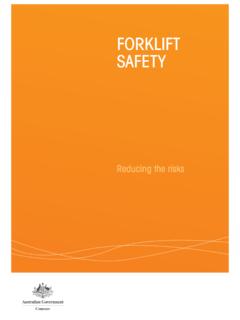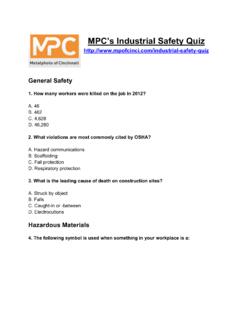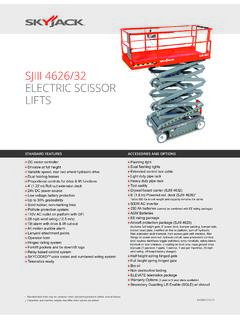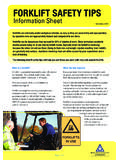Transcription of OSHA Requirement for checklists before putting forklift ...
1 osha requirements for checklists before putting a forklift into use What does osha require regarding forklift checklists ? The Occupational Safety and Health Administration ( osha ) requires that all forklift operator training programs include instruction explaining how operators are to examine forklift trucks before placing them in operation. Standard (l)(3) reads: Training program content. Powered industrial truck operators shall receive initial training in the following topics, except in topics which the employer can demonstrate are not applicable to safe operation of the truck in the employer s vehicle inspection and maintenance that the operator will be required to perform; (l)(3)(i)(J). Despite this Requirement , A very high percentage of forklift users are not aware that they are violating an osha mandate if they fail to perform these inspections.
2 This examination Requirement is found in osha s rules for Powered Industrial Trucks, The specific Requirement is found in osha Reg: (q)(7) and reads, Industrial trucks shall be examined before being placed in service, and shall not be placed in service if the examination shows any condition adversely affecting the safety of the vehicle. Such examination shall be made at least daily. Where industrial trucks are used on a round-the-clock basis, they shall be examined after each shift. Defects when found shall be immediately reported and corrected. Exactly what components of their forklift trucks does osha require an operator to examine? This seems clear enough to those of us in the forklift business, but how clear is this to the average, possibly non-technically inclined, customer?
3 If customers seek clarification in the osha regulations, they may find that this resource is not much help. There is NO specific regulation of what must be checked, just that a preshift checklist be done. The closest the osha regulations come to clarifying exactly what the operator is examining for in (q)(7) is found in the first sentence of (q)(10), Industrial trucks shall be kept in a clean condition, free of lint, excess oil, and grease. Noncombustible agents should be used for cleaning trucks. Besides the general guidelines osha covers in (q)(10), all the daily checklists I ve been exposed to include checks of fluid levels and safety checks not specifically listed in What should an operator check during the visual pre-start check?
4 General condition and cleanliness. Floor - clear of objects that could cause an accident. Overhead - no obstructions---interfering with safe forklift usage. Nearby objects to avoid as you drive away. Fire extinguisher - present and charged. Engine oil level, fuel level, radiator water level (LPG, gas and diesel forklifts). Battery - fully charged; no exposed wires; plug connections not loose, worn or dirty; vent caps not clogged; electrolyte levels in cells is adequate; secured in place by holddowns or brackets. Bolts, nuts, guards, chains, or hydraulic hose reels not damaged, missing or loose. Wheels and tires - check for wear, damage, and air pressure, if pneumatic tires. Forks - forks not bent; no cracks present; positioning latches in good working condition; carriage teeth not broken, chipped or worn.
5 Chain anchor pins - not worn, loose or bent. Fluid leaks - no damp spots or drips. Hoses - held securely; not loose, crimped, worn or rubbing. Horn - working and loud enough to be heard in working environment; other warning devices operational. Seatbelt and/or operator restraint device (if equipped) - belts and restraints work properly; no visible wear or damage; anchors, buckles, etc. function properly. Overhead guard - no damaged areas. What should an operator check during the operational pre-start check? Foot Brake - pedal holds, unit stops smoothly. Parking Brake - holds against slight acceleration. Lift Mechanism - operates smoothly (check by raising forks to max height then lowering forks). Tilt Mechanism - moves smoothly, holds (check by tilting mast all the way forward and backward).
6 Deadman Seat Brake - holds when operator rises from seat. Clutch and Gearshift - shifts smoothly with no jumping or jerking. Dash Control Panel - all lights and gauges are operational. Steering - moves smoothly. Cylinders and Hoses - not leaking after above checks. Listen for any unusual sounds or noises. Lights - headlights and warning lights are operational. Report any problems in daily check to the supervisor immediately. SAMPLE PAPER CHECKLIST Int Comb Engine Industrial Truck - Gas/LPG/Diesel Truck Record of Fuel Added Date Operator Fuel Truck# Model# Engine Oil Department Serial# Radiator Coolant Shift Hour Meter Hydraulic Oil SAFETY AND OPERATIONAL CHECKS (PRIOR TO EACH SHIFT) Have a qualified mechanic correct all problems.
7 Engine Off Checks OK Maintenance Leaks Fuel, Hydraulic Oil, Engine Oil or Radiator Coolant Tires Condition and Pressure Forks, Top Clip Retaining Pin and Heel Check Condition Load Backrest Securely Attached Hydraulic Hoses, Mast Chains, Cables and Stops Check Visually Overhead Guard Attached Finger Guards Attached Propane Tank (LP Gas Truck) Rust Corrosion, Damage Safety Warnings Attached (Refer to Parts Manual for Location) Battery Check Water/Electrolyte Level and Charge All Engine Belts Check Visually Hydraulic Fluid Level Check Level Engine Oil Level Dipstick Transmission Fluid Level Dipstick Engine Air Cleaner Squeeze Rubber Dirt Trap or Check the Restriction Alarm (if equipped) Fuel Sedimentor (Diesel)
8 Radiator Coolant Check Level Operator's Manual In Container Nameplate Attached and Information Matches Model, Serial Number and Attachments Seat Belt Functioning Smoothly Hood Latch Adjusted and Securely Fastened Brake Fluid Check Level Engine On Checks Unusual Noises Must Be Investigated Immediately OK Maintenance Accelerator or Direction Control Pedal Functioning Smoothly Service Brake Functioning Smoothly Parking Brake Functioning Smoothly Steering Operation Functioning Smoothly Drive Control Forward/Reverse Functioning Smoothly Tilt Control Forward and Back Functioning Smoothly Hoist and Lowering Control Functioning Smoothly Attachment Control Operation Horn and Lights Functioning Cab (if equipped) Heater, Defroster, Wipers Functioning Gauges.
9 Ammeter, Engine Oil Pressure, Hour Meter, Fuel Level, Temperature, Instrument Monitors Functioning Operator's Daily Checklist - Electric Industrial Truck Record of Fluid Added Date Operator Battery Water Truck# Model# Hydraulic Oil Department Serial# Shift Drive Hour Meter Reading Hoist Hour Meter Reading SAFETY AND OPERATIONAL CHECKS (PRIOR TO EACH SHIFT) Have a qualified mechanic correct all problems. Motor Off Checks OK Maintenance Leaks Hydraulic Oil, Battery Tires Condition and Pressure Forks, Top Clip Retaining Pin and Heel -- Condition Load Backrest Extension Attached Hydraulic Hoses, Mast Chains, Cables & Stops Check Visually Finger Guards Attached Overhead Guard Attached Safety Warnings Attached (Refer to Parts Manual for Location)
10 Battery Water/Electrolyte Level and Charge Hydraulic Fluid Level Dipstick Transmission Fluid Level Dipstick Operator's Manual in Container Capacity Plate Attached Information Matches Model, Serial Number and Attachments Battery Restraint System Adjust and Fasten Operator Protection Sitdown Truck - Seat Belt Functioning Smoothly Man-up Truck Fall protection/Restraining means - Functioning Brake Fluid Check level Motor On Checks (Unusual Noises Must Be Investigated Immediately) OK Maintenance Accelerator Linkage Functioning Smoothly Parking Brake Functioning Smoothly Service Brake Functioning Smoothly Steering Operation Functioning Smoothly Drive Control Forward/Reverse Functioning Smoothly Tilt Control Forward and Back Functioning Smoothly Hoist and Lowering Control Functioning Smoothly Attachment Control Operation Horn Functioning Lights & Alarms (where present) Functioning Hour Meter Functioning Battery Discharge Indicator Functioning Instrument Monitors Functioning ALL OPERATORS MUST BE TRAINED AND EVALUATED ON THE TYPES OF INDUSTRIAL TRUCKS AND ATTACHMENTS THEY WILL BE OPERATING.







